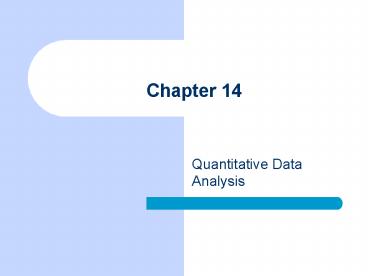Quantitative Data Analysis - PowerPoint PPT Presentation
1 / 12
Title:
Quantitative Data Analysis
Description:
Bivariate Analysis. Introduction to Multivariate Analysis ... Bivariate - subgroup comparisons, describe a case in terms of two ... Bivariate ... – PowerPoint PPT presentation
Number of Views:36
Avg rating:3.0/5.0
Title: Quantitative Data Analysis
1
Chapter 14
- Quantitative Data Analysis
2
Chapter Outline
- Quantification of data
- Univariate Analysis
- Subgroup Comparisons
- Bivariate Analysis
- Introduction to Multivariate Analysis
3
Developing Code Categories
- Two basic approaches
- Beginning with a coding scheme derived from the
research purpose. - Generate codes from the data.
4
Codebook Construction
- Purposes
- Primary guide used in the coding process.
- Guide for locating variables and interpreting
codes in the data file during analysis.
5
Entering Data
- Data entry specialists enter the data into an
SPSS data matrix or Excel spreadsheet. - Optical scan sheets.
- Part of the process of data collection.
6
Quantitative Analysis
- Univariate - simplest form,describe a case in
terms of a single variable. - Bivariate - subgroup comparisons, describe a case
in terms of two variables simultaneously. - Multivariate - analysis of two or more variables
simultaneously.
7
Univariate Analysis
- Describing a case in terms of the distribution of
attributes that comprise it. - Example
- Gender - number of women, number of men.
8
Presenting Univariate Data
- Goals
- Provide reader with the fullest degree of detail
regarding the data. - Present data in a manageable from.
9
Subgroup Comparisons
- Describe subsets of cases, subjects or
respondents. - Examples
- "Collapsing" response categories.
- Handling "don't knows."
10
Bivariate Analysis
- Describe a case in terms of two variables
simultaneously. - Example
- Gender
- Attitudes toward equality for men and women
11
Constructing Bivariate Tables
- Divide cases into groups according to the
attributes of the independent variable. - Describe each subgroup in terms of attributes of
the dependent variable. - Read the table by comparing the independent
variable subgroups in terms of a given attribute
of the dependent variable.
12
Multivariate Analysis
- Analysis of more than two variables
simultaneously. - Can be used to understand the relationship
between two variables more fully.































